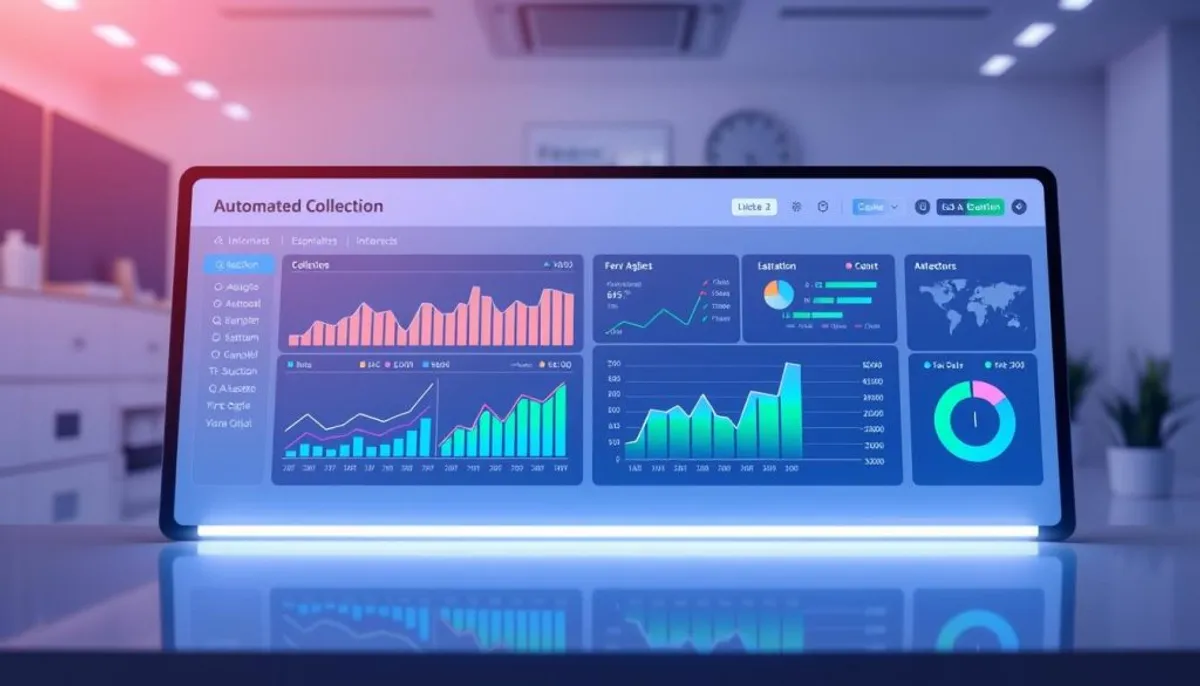In today’s fast-paced business world, streamlining operations is key to success. Automated collection systems are revolutionizing how companies gather and process information. By implementing these tools, businesses can boost efficiency, cut costs, and enhance customer satisfaction.
Data gathering through automation reduces manual labor, allowing staff to focus on high-value tasks. Information extraction becomes seamless, minimizing errors and speeding up processes. This shift towards automated collection is not just a trend—it’s a necessity for companies looking to stay competitive.

Studies show that businesses lose 20-30% of revenue yearly due to inefficient processes. Automated collection addresses this issue head-on. It streamlines invoicing, payment processing, and dispute resolution, leading to faster cash flow and improved customer experiences.
Key Takeaways
- Automated collection reduces manual labor by up to 80%
- Streamlined processes can save companies 20-30% in annual revenue
- Data gathering automation improves accuracy and speeds up information extraction
- Automated systems enhance customer satisfaction through faster service
- Implementing automation can lead to significant cost savings and efficiency gains
Understanding Business Process Automation Fundamentals
Business Process Automation (BPA) has transformed the operational landscape of companies. It transcends mere text mining or web scraping, embracing a holistic strategy to optimize workflows. By addressing manual process inefficiencies, BPA enhances business agility and competitiveness.
The Evolution of Process Automation
The journey of process automation has been profound. Initially, it involved basic data crawling and workflow systems. Today, it has evolved into a critical component of contemporary business, integrating cutting-edge technologies like artificial intelligence and machine learning. These advancements enable the automation of tasks previously reliant on human intervention.
Key Components of Business Process Management
Effective BPA hinges on several critical components:
- Workflow automation
- Data integration
- Analytics
- Smart document processing
These elements synergize to foster a streamlined, efficient business ecosystem. For example, text mining tools can unearth valuable insights from unstructured data. Concurrently, web scraping techniques collect information from diverse online platforms.
Why Automation Matters in Modern Business
In today’s competitive landscape, automation is indispensable. It significantly enhances productivity, diminishes errors, and liberates human resources for strategic endeavors. The benefits are multifaceted:
| Benefit | Impact |
|---|---|
| Time Savings | 75% of IT leaders report saving 4+ hours per week |
| Error Reduction | Significant decrease in manual data entry mistakes |
| Productivity Increase | 20 hours saved weekly in manual data entry for manufacturers |
By harnessing data crawling and other automation methods, enterprises can efficiently manage repetitive tasks. This enables better planning and enhances data security. Such a transformation empowers companies to concentrate on growth and innovation, rather than being bogged down by mundane, time-consuming activities.
Benefits of Automated Collection Systems
Automated collection systems transform business operations through web harvesting and intelligent retrieval. These systems bring numerous benefits, enhancing efficiency and streamlining processes.
Increased Operational Efficiency
Automation speeds up transaction processing, leading to faster updates and settlements. By automating repetitive tasks, businesses can focus on more critical functions. This results in enhanced operational speed and efficiency.
Cost Reduction and Resource Optimization
Automated collection systems significantly cut costs by reducing manual labor and paper usage. This optimization enables businesses to better allocate resources, leading to substantial financial gains.
Enhanced Customer Experience
Web harvesting allows for real-time payment tracking and monitoring, improving cash flow management. Automated reminders and notifications for payment deadlines boost customer satisfaction and retention. This leads to more timely payments and fewer delinquencies.
Improved Data Accuracy and Security
Intelligent retrieval systems minimize errors in manual data entry and processing. This increase in accuracy and reliability of financial data ensures better security and compliance with regulatory requirements. Automated collection solutions maintain detailed transaction records, adhering to industry standards in payment processing.
| Benefit | Impact |
|---|---|
| Cost Savings | Reduced manual labor and paper usage |
| Efficiency | Accelerated transaction processing times |
| Accuracy | Reduced errors in data entry and processing |
| Cash Flow | Improved management through real-time tracking |
| Customer Retention | Enhanced experience through automated reminders |
Introducing ti3: A Revolutionary Collection Platform
In the realm of content aggregation and automated collection, ti3 emerges as a groundbreaking SaaS platform. It addresses the challenge of managing overdue accounts with unparalleled precision and efficiency. Through the automation of reminders and the streamlining of payment collection, ti3 transforms the handling of unpaid invoices for businesses.

Ti3 introduces a novel approach to debt recovery, offering a cost-effective alternative to traditional collection agencies. Its automated collection system ensures the maintenance of positive client relationships while achieving superior results. This equilibrium is essential for businesses aiming to safeguard customer loyalty while ensuring financial stability.
The platform’s core strength resides in its ability to integrate content aggregation with payment processing seamlessly. Ti3 collects and organizes customer data, payment histories, and communication logs, providing a comprehensive view of each account. This aggregated information empowers smart decision-making and the formulation of personalized collection strategies.
- Automated reminder system
- Efficient payment processing
- Intelligent issue escalation
- Comprehensive data aggregation
By adopting ti3, businesses can substantially reduce the time and resources devoted to manual collection efforts. The platform’s automated collection features ensure consistent follow-ups and timely escalations, reducing human error and enhancing recovery rates. With ti3, companies can concentrate on expansion while the platform manages the complexities of account management and debt recovery.
Key Features of Modern Automated Collection Solutions
Modern automated collection solutions have transformed data gathering and information extraction processes. These cutting-edge systems come equipped with various features aimed at streamlining operations and enhancing efficiency.
Smart Payment Processing
Smart payment processing stands out as a transformative element in automated collection. It facilitates transactions with unparalleled speed and precision, significantly reducing errors and accelerating the collection process. This feature integrates flawlessly with existing financial systems, ensuring uninterrupted data flow and immediate updates.
Automated Reminder Systems
Automated reminder systems play a pivotal role in effective data gathering. They dispatch timely notifications to customers regarding outstanding payments, obviating the necessity for manual follow-ups. These systems can be tailored to align with each business’s preferred tone and frequency, thus fostering better customer relationships and increasing collection success rates.
Analytics and Reporting Capabilities
Advanced analytics and reporting tools are indispensable for extracting valuable information from modern collection solutions. They offer profound insights into collection trends, customer behavior, and overall performance metrics. Businesses leverage these analytics to make informed decisions, pinpoint areas for enhancement, and refine their collection strategies.
These essential features collectively forge a comprehensive, efficient collection process. By significantly reducing the need for human intervention and maximizing outcomes, automated collection solutions are revolutionizing financial management and customer engagement for businesses.
Implementation Strategies for Process Streamlining
Automation of business processes can significantly enhance efficiency, quality, and customer satisfaction. To achieve these improvements, companies must concentrate on areas that offer the greatest returns. This involves a strategic approach to identify and automate tasks that are repetitive, standardized, and high-volume.
Text mining and web scraping are invaluable tools for analyzing existing processes and gathering data for optimization. These techniques help in identifying tasks that can benefit from automation, leading to a positive ROI.
Lean methodology principles are fundamental in streamlining processes. By embracing continuous improvement (Kaizen), businesses can reduce costs, enhance quality, and expedite turnaround times. The core principles include:
- Identifying value
- Mapping value streams
- Creating continuous workflows
- Developing pull systems
- Facilitating continuous improvement
Involving stakeholders and gathering user feedback during the design and testing phases is crucial. This ensures that automated processes align with the needs of all parties and function as intended.
| Automation Tool | Best For | Key Feature |
|---|---|---|
| Robotic Process Automation (RPA) | Repetitive tasks | Mimics human actions |
| Business Process Management (BPM) | Complex workflows | End-to-end process optimization |
| AI/ML | Decision-making processes | Intelligent automation |
Continuous monitoring and measurement of automated processes are essential for ongoing improvement. Staying abreast of the latest technologies and best practices in automation enables businesses to refine their operations and foster innovation.
Maximizing ROI Through Automated Collection
Modern businesses can significantly enhance their return on investment (ROI) by adopting automated collection systems. These systems utilize advanced data crawling and web harvesting technologies. This integration streamlines financial processes, leading to notable cost savings.
Cost-Benefit Analysis
Automating financial processes can yield remarkable efficiency gains. Research indicates that companies embracing automation can cut process costs by 30% to 50%. This reduction is attributed to less manual data entry, fewer errors, and faster invoice processing.

Performance Metrics and KPIs
Measuring the effectiveness of automated collection systems requires attention to specific key performance indicators (KPIs). These include processing time, error rates, and enhancements in cash flow. Financial automation solutions often lead to efficiency boosts of 20-30% within the initial year.
Long-term Financial Impact
The long-term financial advantages of automated collection are considerable. By employing data crawling and web harvesting, businesses can manage increased transaction volumes without escalating costs. This scalability supports growth without proportionally increasing operational expenses. Further, automation bolsters compliance with financial regulations, thus reducing the risk of hefty fines or legal complications.
| Benefit | Impact |
|---|---|
| Cost Reduction | 30-50% decrease in process costs |
| Efficiency Improvement | 20-30% increase in first year |
| Error Reduction | Minimized data entry mistakes |
| Scalability | Handling increased volumes without proportional cost increase |
By integrating automated collection systems, businesses can realize substantial ROI. This is achieved through enhanced efficiency, cost reduction, and improved financial precision.
Integration and Compatibility Considerations
Integrating automated collection systems necessitates meticulous planning to ensure seamless operations. Businesses must meticulously evaluate system requirements, data migration, and integration with existing software. This is crucial to maximize the benefits of intelligent retrieval and automated parsing.
System Requirements
Assessing your current infrastructure is paramount when implementing automated collection. It is essential to verify that your systems can accommodate the new software and efficiently process large data volumes. This step is critical for scalability and future growth.
Data Migration Processes
Smooth data migration is paramount to maintaining information integrity. A well-planned migration is necessary to prevent data loss or corruption. Automated parsing tools can significantly streamline this process, ensuring the accurate transfer of critical business data.
API and Third-party Integration
Seamless integration with existing systems is vital for operational efficiency. APIs facilitate the intelligent retrieval of data across platforms, while third-party integrations enhance functionality. These connections create a cohesive ecosystem that significantly boosts overall business performance.
| Integration Aspect | Impact |
|---|---|
| Automated Data Collection | Enhances accuracy, reduces costs |
| Data Quality | 77% struggle with data trustworthiness |
| Manual Integration | Error-prone, causes delays |
| Automated Integration | Reduces time, optimizes resources |
By addressing these integration and compatibility considerations, businesses can fully leverage automated collection systems. This leads to improved efficiency, enhanced data accuracy, and reduced operational costs.
Best Practices for Business Process Optimization
In today’s fast-paced market, business process optimization is key to staying competitive. Implementing best practices allows companies to streamline operations, boost productivity, and enhance customer satisfaction. Let’s dive into some essential strategies for optimizing business processes effectively.
Continuous process analysis is crucial for identifying bottlenecks and inefficiencies. Regular evaluations ensure that processes deliver value and remain efficient over time. Companies should leverage data insights and analytics to pinpoint areas for improvement.
Employee involvement is vital in optimization efforts. Workers often have valuable insights into day-to-day operations. Encouraging feedback and providing adequate training on new systems can lead to smoother implementation of changes.
Automation is a powerful tool for content aggregation and streamlining repetitive tasks. By implementing automated collection systems, businesses can free up employees for more complex projects, reducing costs and maximizing productivity.
| Optimization Strategy | Benefits |
|---|---|
| Continuous Process Analysis | Identifies bottlenecks, ensures value delivery |
| Employee Involvement | Provides valuable insights, smoother implementation |
| Automation Implementation | Reduces costs, increases efficiency |
| Data-Driven Decision Making | Improves accuracy, supports strategic planning |
By adopting these best practices, businesses can foster a culture of continuous improvement. This approach optimizes current processes and prepares organizations for future challenges and opportunities in the ever-evolving business landscape.
Conclusion
Automated collection systems have transformed data gathering and information extraction across various sectors. The Internal Revenue Service’s Automated Collection System (ACS) exemplifies this transformation, collecting $5.4 billion in fiscal year 2013. This achievement underscores the potential for businesses to enhance their operations and efficiency through automation.
The trajectory of automated collection is set to advance with technologies like robotic process automation, artificial intelligence, and machine learning. These innovations are poised to redefine how businesses manage their Order to Cash processes. By choosing and implementing the most suitable software solutions, companies can automate repetitive tasks, elevate efficiency, and uncover valuable customer insights.
The advantages of automated collection systems are evident. They contribute to increased operational efficiency and better customer experiences, providing a competitive advantage in today’s dynamic business landscape. By embracing automation and continually refining their processes, businesses can optimize their collection strategies and maintain a competitive edge in an evolving marketplace.
RelatedRelated articles



